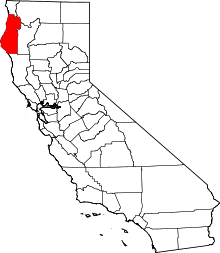Bucksport, California
| Bucksport Kucuwalik[1] Buck's Port | |
|---|---|
| Unincorporated community | |
|
Bucksport is now a part of Eureka, California. | |
 Bucksport Location in California | |
| Coordinates: 40°46′30″N 124°11′32″W / 40.77500°N 124.19222°W | |
| Country | United States |
| State | California |
| County | Humboldt County |
| Elevation[2] | 16 ft (5 m) |
Bucksport (also, Buck's Port) was a town in Humboldt County, California.[2] The original location was 2.5 miles (4 km) southwest of downtown Eureka, on Humboldt Bay about 5 miles (8 km) northeast of entrance.[3] at an elevation of 16 feet (4.9 m).[2] Prior to American settlement a Wiyot village named Kucuwalik stood here.[1]
The townsite was laid out in 1850 by David A. Buck who was a member of the Josiah Gregg party that explored the bay in 1849.[3][4] A post office operated at Bucksport from 1855 to 1863.[3]
Fort Humboldt was founded on the bluff over Bucksport in 1853 under the command of Brevet Lieutenant Colonel Robert C. Buchanan.[5]
Bucksport was a separate community in the 19th century, before better port facilities and political dominance gave the then northern town of Eureka predominance. The town disappeared by 1870 with the area that once comprised the town remaining only as a neighborhood of southern Eureka.[6]
Bucksport and Elk River Railroad Company
Rails on a 56.5 inches (1.44 m) gauge were laid from Bucksport, south along the Elk River, by the Dolbeer and Carson Lumber Company in 1885.[7] Trains began running the following year from Bucksport south and east to Falk's Mill, a distance of 12 miles (19 km) with a stub running north of Bucksport to Holmes Mill in present day Eureka.[7] Baldwin Engines were used to haul trains of lumber from the mill to the port for shipping.[7] In 1894 and 1895, the distance of rails was reduced, and by 1902 traffic on the line was minimal.[7]
In 1931 a stub line was built to Camp Carson.[7] The Bucksport and Elk River Railroad Company was incorporated on 14 May 1932, with J.M. Carson as president, and operated until 15 January 1953.[7] In 1934, the old Baldwin engines were retired and replaced by Dolbeer and Carson Lumber Company engines.[7] The rails were scrapped in April 1953.[7]
References
- 1 2 Golla, Victor, California Indian Languages University of California Press, 2 August 2011, 400 pages
- 1 2 3 U.S. Geological Survey Geographic Names Information System: Bucksport, California
- 1 2 3 Durham, David L. (1998). California's Geographic Names: A Gazetteer of Historic and Modern Names of the State. Clovis, Calif.: Word Dancer Press. p. 29. ISBN 1-884995-14-4.
- ↑ Historic Spots in California, Stanford University Press, 2002
- ↑ Strobridge, William F. (1994). Regulars in the Redwoods: The U.S. Army in Northern California, 1852-1861. Arthur H. Clarke Company. pp. 255–257. ISBN 0-87062-214-5.
- ↑ Humboldt Bay Historic and Cultural Resource Characterization & Roundtable
- 1 2 3 4 5 6 7 8 Robertson, Donald B., Encyclopedia of Western Railroad History: California, Caxton Press, Caldwell, Idaho, 1986, (OCoLC)570461795
Additional reading
Rohde, Jerry (September 11, 2008). "The Sonoma Gang Remembering the genocidal scum who built Arcata". North Coast Journal. Retrieved 17 April 2014.
Coordinates: 40°46′30″N 124°11′32″W / 40.77500°N 124.19222°W

